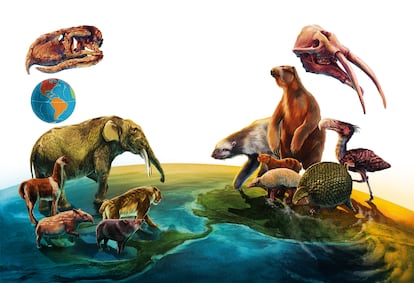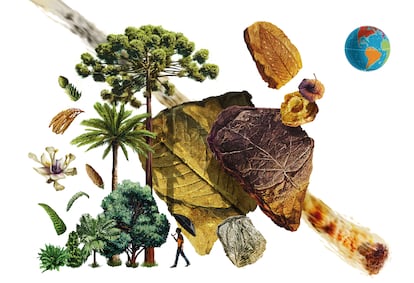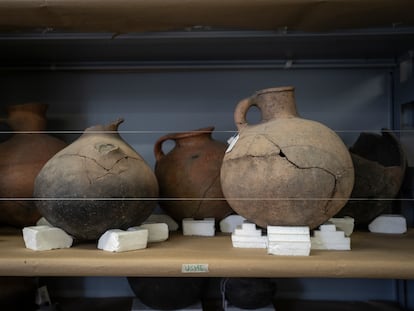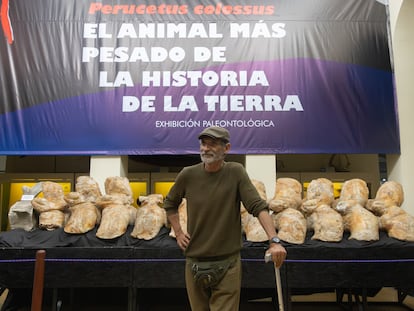What can fossils teach us about biodiversity?
A new book on paleontology explores the history and diversity of ecosystems in Colombia. Experts argue that to protect today’s ecosystems it is essential to understand their history and how they evolved

Over 66 million years ago, the Chicxulub meteorite crashed into planet Earth on the Mexican Yucatán Peninsula. It had a diameter of about 10 kilometers (6 miles, or the size of a mountain) and traveled at a speed of 20 kilometers (12 miles) per second. Its impact was one hundred million times more powerful than the largest thermonuclear bomb ever detonated in history, the Tsar bomb. The meteorite evaporated the sea in the impact zone and created waves of rocks 32 km (20 miles) high. Perhaps the most devastating consequence was that global temperatures suddenly dropped by 28 degrees Celsius (50.4 degrees Fahrenheit). Scientists estimate that between 70 and 75% of plants and animals became extinct as a result of this coalition.
Currently, the most diverse ecosystems on the planet are the tropical forests of Central and South America. These are a product of this cosmic accident and evolution over the last 66 million years on the planet. “Although the way in which these ecosystems emerged is still a mystery, the fossil records found in La Guajira and the Bogotá savanna allow us to trace their origin to the Paleocene, five million years after the great catastrophe that made the dinosaurs go extinct,” explains the book Hace tiempo: un viaje paleontológico ilustrado por Colombia [Long Ago: An illustrated paleontological journey through Colombia].
The pages of this book bring to life the different chapters of the history of our planet, which have been recorded in the rocks as fossils. In it appear animals such as the Titanoboa, a snake more than ten meters (32 feet) long and weighing around 1,100 kilos (2,425 pounds), and which slithered around the tropical jungles of Guajira 66 million years ago; or the giant sloth bears that lived 50 million years ago and helped distribute fruit trees like avocado and papaya throughout the continent.
The book is the product of an alliance between the Humboldt Institute, a non-profit organization linked to Colombia’s Ministry of Environment and Sustainable Development, and the Smithsonian Tropical Research Institute in Panama. It also features the work of 32 Colombian scientists who contributed as authors. For example, Fabiany Herrera, curatorial assistant of paleobotany at the Field Museum in Chicago, wrote the article on the Paleocene period.
The launch of the second edition of this book that tells the story of Colombia’s biodiversity took place on September 10. The book can be downloaded for free from the Humboldt Institute’s virtual repository, or a physical copy can be purchased from its store. Diego Ochoa, the director of public relations at the Humboldt Institute, says that this book is part of an effort for “the Colombian people to learn about biodiversity.”
Colombia is recognized as one of the most biodiverse countries on the planet and “something that the fossil record has taught us is that producing biodiversity requires geological time,” says Carlos Jaramillo. The scientist is one of the country’s most important paleontologists and has studied tropical fossils for more than 18 years at the Smithsonian Tropical Research Institute in Panama. He has led archeological excavations in several Central and South American countries, mentors several paleontologists, and is one of the book’s editors.
Thanks to the fossil record, we know that on average a species lasts 3 million years on the planet. Scientists estimate that in the last 485 million years, there have been around 1.6 billion species. 99% are extinct. Jaramillo argues that current biodiversity is the product of millions of years of evolution. For example, the flowering plants that dominate the tropics today appeared about 150 million years ago at the beginning of the Cretaceous period. However, climate change and the worldwide acceleration of species extinction (several scientists claim that we are experiencing a sixth major extinction event driven by human activity) are putting the biodiversity of Colombia and the world at risk.

Paleontologists like Jaramillo argue that to protect ecosystems in the present, it is necessary to understand their past and how they evolved. But Colombia has invested very little in scientific research. The area has been neglected regardless of the ideology of the government in power. For example, the country does not have a national museum of natural history where you can learn about evolution and biodiversity; and there are no universities that offer a paleontology degree.
“My favorite classes were natural sciences, where they showed us documentaries about fossils and the history of the earth. But they never told us anything about Colombia,” says Cristian David Benavides Cabra, who recently completed his master’s degree in geology at the National University of Colombia. He studied Colombian marine ecosystems during the Cretaceous and plans to study for a doctorate abroad.
As a student, Benavides had the opportunity to co-author the article that first described the Sachicasaurus vitae species, a plesiosaur (short-necked marine reptile) measuring 10 meters in length (more or less the equivalent of a three-story building), with a two-meter head (enough to swallow a human in a single bite), and which swam in the Cretaceous seas 125 million years ago. Sadly, the vast majority of Colombian students, including all the paleontologists we interviewed, and the author of this text, did not learn about our country’s biodiversity or fossils in school.
The first edition of the book Hace Tiempo was launched in 2018 as a digital product and some physical copies that were distributed to different public schools and at-risk populations. This edition was never for sale. However, it was a very successful project. It is the most downloaded virtual book on the Humboldt Institute website and won an award from the Alejandro Ángel Escobar Foundation.
Dream about dinosaurs
“I dare say that many children in Colombia dream about dinosaurs. But we don’t have the right places to promote those interests,” says Dirley Cortes, a doctoral student at McGill University in Canada. She wrote a new chapter (on Cretaceous marine reptiles) that appears in the second edition. Cortés was born in Villa de Leyva, one of the places with the greatest abundance of fossils in the country, “there are practically fossils in the patio of my house,” she says with a smile.
The second edition also includes a new chapter on Perijasaurus lapaz, a giant sauropod dinosaur that was discovered in 2018 in the Serranía del Perijá. Its name pays tribute to both the place where it was discovered and the peace agreement between the Colombian government and the FARC signed in 2016, which allowed paleontologists to explore the region for the first time in decades.
Luz Helena Oviedo is an educator, scientific outreach, and book editor. She says she went to great lengths to ensure that the text reflects the enthusiasm that paleontologists have for the science and the fossils they study. She believes that it is very important to pass on this knowledge and do scientific outreach with various audiences and communities. That is why, as part of the promotion of the first edition, they visited “29 of the 32 departments [administrative regions]” of Colombia. She hopes that with the second edition they will be able to visit the remaining three.

For Oviedo, a large part of the book’s success “is the game, the conversation, between text and illustration.” The images were made by Guillermo Torres Carreño, art director of Puntoaparte. Several serve as pedagogical elements that help readers understand these animals and the extinct ecosystems, as well as the science that studies them. The book has scenes of what ecosystems would have looked like in the past and comparisons that help the audience understand the magnitude of these animals, like the Megalodon, a shark that swam 3 million years ago and was as big as a bus.
Edwin Cadena was born in Zapatoca in the Santander region of Colombia, near the Tatacoa desert. The area is one of the places with the largest amount of marine fossils from the Cretaceous period. In the town bookstore, he learned that rocks with “strange” shapes were fossils. He studied undergraduate geology at the Industrial University of Santander and completed his master’s and doctorate in the United States. Today he is a professor and director of the postgraduate area at the Del Rosario University in Bogotá and an expert in the evolution of tropical sea turtles. He also wrote the chapter on giant turtles, which includes species such as Demastochelys padillai, one of the oldest sea turtles in the world, which was the size of a compact car.
Cadena says that in recent years there has been a “paleontological boom in Colombia” where the number of Colombian researchers, the fossils discovered, and the areas to be explored have increased significantly. In order for this science to continue developing and have an impact on the conservation of today’s ecosystems, he says that it is very important that children “not only learn from the T. rex, but also learn from the fossils that lived here.”
Sign up for our weekly newsletter to get more English-language news coverage from EL PAÍS USA Edition
Tu suscripción se está usando en otro dispositivo
¿Quieres añadir otro usuario a tu suscripción?
Si continúas leyendo en este dispositivo, no se podrá leer en el otro.
FlechaTu suscripción se está usando en otro dispositivo y solo puedes acceder a EL PAÍS desde un dispositivo a la vez.
Si quieres compartir tu cuenta, cambia tu suscripción a la modalidad Premium, así podrás añadir otro usuario. Cada uno accederá con su propia cuenta de email, lo que os permitirá personalizar vuestra experiencia en EL PAÍS.
¿Tienes una suscripción de empresa? Accede aquí para contratar más cuentas.
En el caso de no saber quién está usando tu cuenta, te recomendamos cambiar tu contraseña aquí.
Si decides continuar compartiendo tu cuenta, este mensaje se mostrará en tu dispositivo y en el de la otra persona que está usando tu cuenta de forma indefinida, afectando a tu experiencia de lectura. Puedes consultar aquí los términos y condiciones de la suscripción digital.










































